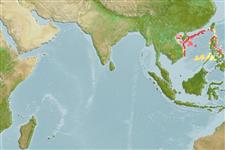Elasmobranchii (tubarões e raias) (sharks and rays) >
Orectolobiformes (Carpet sharks) >
Parascylliidae (Collared carpet sharks)
Etymology: Cirrhoscyllium: cirrus, Latin for curl or tendril, referring to barbels on throat; skylion, Greek for dogfish or small shark. (See ETYFish); expolitum: Latin for varnished, referring to how the shark’s body, when dry, “glistens as though varnished, owing to the peculiar character of the dermal denticles”. (See ETYFish).
More on authors: Smith & Radcliffe.
Environment: milieu / climate zone / depth range / distribution range
Ecologia
marinhas demersal; intervalo de profundidade 180 - 190 m (Ref. 43278). Deep-water; 23°N - 10°N, 105°E - 125°E
Western Pacific: South China Sea off China to the Philippines (Luzon). Gulf of Tonkin, Vietnam and Japan (off the Tanegashima Islands).
Tamanho / Peso / Idade
Maturity: Lm ? range ? - ? cm
Max length : 34.0 cm TL macho/indeterminado; (Ref. 247)
Espinhos dorsais (total) : 0; Espinhos anais: 0. Genus: pair of barbels on throat; color pattern of dark saddles, no light or dark spots (Ref. 43278).
Species: Six or possibly ten diffuse saddle marks on dorsal surface, saddles above abdomen rounded and continuing above pelvic-fin bases, not C-shaped, head length three times first dorsal-fin base (Ref. 43278). Gill region without collar marking (Ref. 13572).
Found on the continental shelf, offshore on or near the bottom (Ref. 247). Food habits unknown (Ref. 13572). Oviparous (Ref. 43278, 50449). Interest to fisheries unknown (Ref. 13572). Probably taken as discarded by-catch of offshore trawl fisheries in the area (Ref. 43278).
Life cycle and mating behavior
Maturities | Reprodução | Spawnings | Egg(s) | Fecundities | Larvas
Oviparous, paired eggs are laid. Embryos feed solely on yolk (Ref. 50449).
Compagno, L.J.V., 1984. FAO Species Catalogue. Vol. 4. Sharks of the world. An annotated and illustrated catalogue of shark species known to date. Part 1 - Hexanchiformes to Lamniformes. FAO Fish. Synop. 125(4/1):1-249. Rome, FAO. (Ref. 247)
Categoria na Lista Vermelha da IUCN (Ref. 130435)
Ameaça para o homem
Harmless
Utilização humana
Ferramentas
Relatórios especiais
Descarregue XML
Fontes da internet
Estimates based on models
Preferred temperature (Ref.
123201): 8.5 - 21.9, mean 13.1 °C (based on 71 cells).
Phylogenetic diversity index (Ref.
82804): PD
50 = 0.6289 [Uniqueness, from 0.5 = low to 2.0 = high].
Bayesian length-weight: a=0.00389 (0.00180 - 0.00842), b=3.12 (2.94 - 3.30), in cm total length, based on all LWR estimates for this body shape (Ref.
93245).
Nível Trófico (Ref.
69278): 3.6 ±0.5 se; based on size and trophs of closest relatives
Resiliência (Ref.
120179): Baixo, tempo mínimo de duplicação da população 4,5 - 14 anos (Fec assumed to be <100).
Fishing Vulnerability (Ref.
59153): Low vulnerability (24 of 100).
